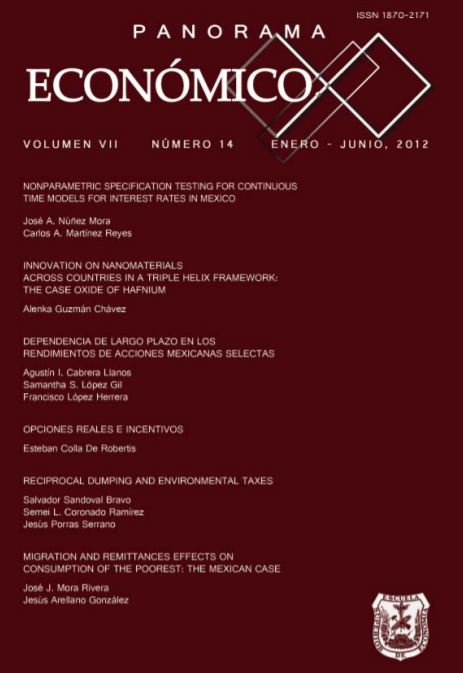Migration and remittances effects on consumption of the poorest:The mexican case
Contenido principal del artículo
Este trabajo presenta evidencia empírica sobre el efecto de las remesas en los patrones de gasto de hogares rurales que viven en algunas de las zonas más pobres de México. Utilizando datos de las encuestas del programa Progresa-Oportunidades de los años 1997 al 2000, se desarrolla un modelo econométrico que considera el proceso de autoselección involucrado en el fenómeno migratorio, para estimar el impacto que tiene la probabilidad de recibir remesas, internas y externas, en los patrones de gasto de estos hogares. Los resultados señalan que existen efectos significativos en ciertas categorías de gasto. Dichos hallazgos indican que los hogares con mayor probabilidad de recibir remesas tienen mayor propensión a gastar en categorías de gasto relacionadas con la inversión física y humana.
Adams,R.H.Jr., A. Cuecuecha and J. Page (2008), “Remittances, Consumption and Investment in Ghana”, World Bank Policy Research Working Paper No. 4515.
Adams, R. H. Jr. (2005), “Remittances, Household Expenditure and Investment in Guatemala”, World Bank Policy Research, Working Paper No. 3532.
(1998), “Remittances, Investment and Rural Asset Accumulation in Pakistan” , Economic Development and Cultural Change, vol. 47, no. 1, 155-73.
Amuedo-Dorantes, Catalina, Tania Sainz and Susan Pozo (2007), “Remittances and Healthcare Expenditure Patterns of Populations in Origin Communities: Evidence from Mexico”, Integration and Trade Journal, no. 27, 159-184.
Angelucci, M. (2005), “Aid and Migration: an analysis of the impact of Progresa on the timing and size of labor migration”, University of Arizona-Eller College of Business and Public Administration; Institute for the Study of Labor (IZA), Discussion Paper No. 1187.
Alderman, H. (1996), “Saving and Economic Shocks in Rural Pakistan”, Journal of Development Economics, vol. 51, no. 2, 343-365.
Alcaraz, Carlo and D. Chiquiar (2007), “Emigration, Schooling and Child Labor in Rural Mexico”. Banco de México, Dirección General de Investigación Económica, mimeo.
Amemiya, T. (1974), “Mutivariate Regression and Simultaneous Equation Models When the Dependent Variables are Truncated Normal”, Econometrica, vol. 42, no. 6, 999-1012.
Azuara, O. (2009), “Does Poverty Alleviation Increase Migration? Evidence from Mexico, Munich Personal RePEc Archive (MPRA), Paper No. 17599.
Barham, B. and S. Boucher (1998), “Migration, Remittances, and Inequality: Estimating the Net Effects of Migration on Income Distribution”, Journal of Development Economics, vol. 55, no. 2, 307-331.
Borraz, F. (2005), “Assessing the Impact of Remittances on Schooling: the Mexican Experience”, Global Economy Journal, vol.5, pp. 1-30.
Buddelmeyer, H. and E. Skoufias (2003), “An Evaluation of the Performance of Regression Discontinuity Design on PROGRESA”, Working Paper.
Chami, R., C. Fullenkamp and S. Jahjah (2003), “Are Immigrant Remittance Flows a Source of Capital for Development?” International Monetary Fund (IMF), Working Paper 03/189, Washington DC.
Comité Técnico para la Medición de la Pobreza (CTMP) (2002), “Medición de la pobreza: variantes metodológicas y estimación preeliminar”, Secretaría de Desarrollo Social: Serie Documentos de Investigación 1.
Consejo Nacional de Población (2002), Índice de Intensidad Migratoria México- Estados Unidos, CONAPO.
Cornelius, W. (1990), “Labor Migration to the United States: Development Outcomes and Alternatives in Mexican Sending Communities”, Commission for the Study of International Migration and Cooperative Economic Development, Washington, D.C.
Cuecuecha, A. (2008) “The Effect of Remittances and Migration on Human Capital: Evidence from Mexico”, Instituto Tecnológico Autónomo de México (ITAM), mimeo.
De Brauw, A. and J. Giles (2008), “Migrant Labor Markets and the Welfare of Rural Households in the Developing World: Evidence from China”, World Bank Policy Research Working Paper 4585.
Diaz-Briquets, S. and S. Weintraub (1991), Migration, Remittances, and Small Business Development: Mexico and Caribbean Basin Countries, Boulder: Westview Press.
Durand, J. and D. S. Massey (1992), “Mexican Migration to the United States: A Critical Review”, Latin American Research Review, vol. 27, no. 22, 3-42.
Edwards, A. and M. Ureta (2003), “International Migration, Remittances and Schooling: Evidence from El Salvador”, Journal of Development Economics, vol. 72, no. 2, 429-461.
Escobar, A. and M.de la O. Martinez (1990), “Small-scale Industry and International Migration in Guadalajara, Mexico’, Commission for the Study ofInternational Migrationand Cooperative Economic Development, Working Paper No. 53, Washington, DC.
Esquivel, Gerardo and A. Huerta-Pineda (2007), “Remittances and Poverty in Mexico: A Propensity Score Matching Approach”, Integration and Trade Journal, no. 27: 45-71.
García, J. and J. M. Labeaga (1996), “Alternative Approaches to Modelling Zero Expenditure: An Application to Spanish Demand for Tobacco”, Oxford Bulletin of Economics and Statistics, vol. 58, no. 3, 489-506.
Goldring, L. (1990), “Development and Migration: A Comparative Analysis of Two Mexican Migrant Circuits”, Commission for the Study of International Migration and Cooperative Economic Development. Washington, D.C.
Hanson, G. H. (2007), “Emigration, Labor Supply, and Earnings in Mexico”, in G. J. Borjas, ed., Mexican Immigration, University of Chicago and the National Bureau of Economic Research, pp. 289-328
Hanson, G. H. and Ch. Woodruff (2003), “Emigration and Educational Attainment in Mexico”, Universidad de California, San Diego, mimeo.
Heien, D. and C. R. Wessells (1990), “Demand systems estimation with microdata: a censored regression approach”, Journal of Business and Economic Statistics, vol. 8, no. 1, 365-71.
Hildebrandt, N. and D. McKenzie (2005), “The Effects of Migration on Child Health in Mexico. World Bank Policy Research”, Working Paper No. 3573. INEGI (2001), XII Censo de Poblacion y Vivienda. Resultados Definitivos,
International Labour Office (2006), “International Labour Migration and Development: the ILO Perspectives”, 61st Session of the General Assembly High-level Dialogue on International Migration and development 14-15.
Instituto Nacional de Ciencias Médicas y Nutrición Salvador Zubirán (2003), Cambios en la situación nutricional de México de 1990 a 2000 a través de un Indice de Riesgo Nutricional por Municipio, INCMNSZ-Sociedad Latinoamericana de Nutrición.
Jabarin, A. S. (2005), “Estimation of meat demand system in Jordan: an almost ideal demand system”, International Journal of Consumer Studies, vol. 29, no. 3, 232-238.
Kanaiaupuni, S. M. and K. M. Donato (1999), “Migradollars and mortality: The effects of migration on infant survival in Mexico”, Demography, vol. 36, no. 3, 339-353.
Lazaridis, P, (2003), “Household Meat Demand in Greece: A Demand Systems Approach Using Microdata” , Agribusiness, vol. 19, no. 1, 43-59.
Lee, Lung-Fei (1978), “Simultaneous Equation Models with Discrete and Censored Dependent Variables”, in: Structural Analysis and Discrete Data with Econometric Applications, P. Manski and D. McFadden (eds), Cambridge, MA, MIT Press.
López-Córdova, E. (2006), Globalization, Migration and Development: The Role of Mexican Migrant Remittances, Inter-American Development Bank, Washington, DC.
Massey, D.S., R. Alarcón, J. Durand and H. González (1987), Return to Aztlan: The Social Process of International Migration from Western Mexico, University of California Press.
Massey, D. S., J. Arango, G. Hugo, A. Kouaouci, A. Pellegrino and J. E. Taylor (1994), “An Evaluation of International Migration Theory: The North American Case”, Population and Development Review, vol. 20, no, 4, pp. 699-751.
Massey, D. S., J. Arango, G. Hugo, A. Kouaouci, A. Pellegrino and J. E. Taylor (1993), “Theories of International Migration: A Review and Appraisal”, Population and Development Review, vol. 19, no. 3, pp. 431-66.
Meza, L. and C. Pederzini (2009), “Migración internacional y escolaridad como medios alternativos de movilidad social: el caso de México", Estudios Económicos, Extraordinary Number, 163-206.
Mendelshon, R., P. Christensen and J. Arellano-González, “Ricardian Analysis of Mexican Farms”, Environmental and Development Economics, forthcoming.
Mora, J. and J. Arellano (2009), “Effects of Remittances on Household Expenditure Patterns of Rural Mexico. Global Citizen Project”, Working Paper.
Papademetrious, D. G. and P. L. Martin (1991), `The Unsettled Relationship: Labor Migration and Economic Development, New York: Greenwood Press.
Parker, S. W. P. Todd and K.I. Wolpin (2006) “Within-Family Program Effect Estimators: The Impact of Oportunidades on Schooling in Mexico”, Working Paper.
Perali,F., and J.P. Chavas (2000) “Estimation of Censored Demand Equations from Large Cross-Section Data” , American Journal of Agricultural Economics vol. 82, no. 4, 1022-37.
Reichert, J. S. (1981), “The Migrant Syndrome: Seasonal U.S. Wage Labor and Rural Development in Central Mexico”, Human Organization, vol. 40, no. 1, 56-66.
Shonkwiler, J.S. and S.T. Yen (1999), “Two-step estimation of a censored system of equations”, American Journal of Agricultural Economics, vol. 81, no. 4, 972-82.
Shroff, K. (2009), “Impact of Remittances on Poverty in Mexico”, Global Citizen Project, Working Paper.
Shultz, T.P. (2001) “School Subsidies for the Poor: Evaluating the Mexican Progresa Poverty Program”, Yale University, Economic Growth Center, Center Discussion Paper No. 834.
Skoufias, E. and S.W. Parker (2001), “Conditional cash transfers and their impact on child work and schooling: evidence from the Progresa program in Mexico”, International Food Policy Research Institute, Food Consumption and Nutrition Division, Discussion Paper No. 123.
Stark, O. (1991), The migration of labor, Cambridge, MA: Blackwell.
Stecklov, G., P. Winters, M. Stampini and B. Davis (2003), “Can Public Transfers Reduce Mexican Migration? A Study Based on Randomized Experimental Data”, Agricultural and Development Economics Division of the Food and Agriculture Organization of the United Nations (FAO- ESA), Working Paper 03-16.
Suarez, J.C and Z. Avellaneda (2007), “ Juanita’s Money Order: Income effects on Human Capital Investment in Mexico”, University of California, Berkeley, Working Paper 200703.
Taylor, J. E. (1999), “The new economics of labour migration and the role of remittances in the migration process”, International Migration, vol. 37, no. 1, pp. 63-87.
Taylor, J. E. and P. L. Martin (2001), “Human Capital: Migration and Rural Population Change”, Handbook of Agricultural Economics, vol. 1, Part 1, Chapter 9: 457-511.
Taylor, J. E., J. Arango, G. Hugo, A. Kouaouci, D. S. Massey and A. Pellegrini (1996), “International Migration and Community Development” Population Index, vol. 62, no. 2, 181-212.
Taylor, J. E., S. Rozelle and A.de Brauw (2003), “Migration and Incomes in Source Communities: A New Economics of Migration Perspective from China” , Economic Development and Cultural Change, vol. 52, no. 51, 75-101.
Todd, P. and K. I. Wolpin (2006), “Assessing the Impact of a School Subsidy Program in Mexico: Using a Social Experiment to Validate a Dynamic Behavioral Model of Child Schooling and Fertility”, The American Economid Review, vol. 96, no. 5, 1:34.
Van de Ven, Wynand P.M.M. and Bernard M.S. van Praag (1981), “The demand for deductibles in private health insurance: A probit model with sample selection, Journal of Econometrics, vol. 17, no. 2, 229-252.
Woodruff, Ch. and R. Zenteno (2007), “Migration Networks and Microenterprises in Mexico”, Journal of Development Economics, vol. 82, no. 2, pp. 509-528.
World Bank (2006), Global Economic Prospects 2006: Economic Implications of Remittances and Migration, Washington D.C.: IBRD/The World Bank.
Unger, K. (2005), “Regional Economic Development and Mexican Out- Migration”, NBER Working Paper No. W11432.
United Nations (2002), International Migration Report 2002, New York: Population Division, United Nations.
Yang, D. (2005), “International Migration, Human Capital and Entrepreneurship: Evidence from Philippine Migrants’ Exchange Rate Shocks”, World Bank Policy Research Working Paper 3578.
Detalles del artículo

Esta obra está bajo una licencia internacional Creative Commons Atribución-NoComercial-SinDerivadas 4.0.







